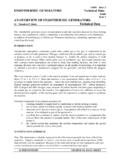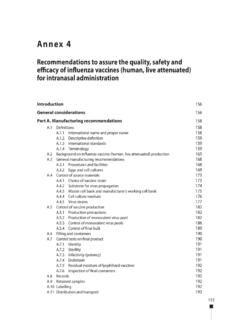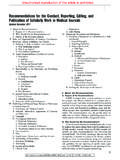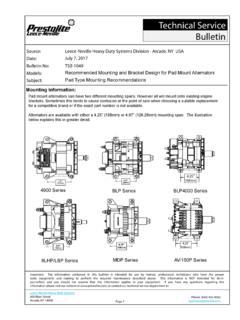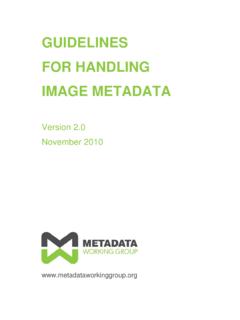Transcription of Recommendations for Control of Radiated …
1 AN-0971. APPLICATION NOTE. One Technology Way Box 9106 Norwood, MA 02062-9106, Tel: Fax: Recommendations for Control of Radiated emissions with isoPower Devices by Mark Cantrell INTRODUCTION. iCoupler digital isolators with integrated isolated power with proper design choices, isoPower devices can easily meet (isoPower ) employ isolated dc-to-dc converters that switch CISPR Class A (FCC Class A) emissions standards. with care, currents of ~700 mA at frequencies as high as 300 MHz. these products can also meet CISPR Class B and FCC Part 15, Operation at these high frequencies raises concerns about Subpart B, Class B (FCC Class B) standards in an unshielded Radiated emissions and conducted noise. PCB layout and environment. This application note examines PCB-related EMI. construction is a very important tool for controlling Radiated mitigation techniques, including board layout and stack-up issues.
2 emissions and noise from applications containing isoPower The techniques, example layouts, and measurements described in components. This application note identifies the radiation this application note are highly dependent on the options available mechanisms and offers specific guidance on addressing them. in PCB construction. A 4-layer PCB is required to implement the Several standards for Radiated emissions exist. In the , evaluated EMI Control techniques. Availability of more internal the Federal Communications Commission (FCC) controls PCB layers offers the same EMI reductions within smaller geome- the standards and test methods. In Europe, the International try PCBs. For the purposes of this application note, a 4-layer board Electrotechnical Commission (IEC) generates standards, and was designed and manufactured using materials and structures well CISPR test methods are used for evaluating emissions .
3 The within industry norms. methods and pass/fail limits are slightly different under the Control of emissions from signal cables and chassis shielding two standards. Although this application note is written with techniques are outside of the scope of this application note. reference to CISPR standards, all results are applicable to both standards. OSC RECT REG. OPEN LOOP with LINEAR REGULATOR. ADuM524x OSC RECT REG OSC RECT. PWM. 07541-001. FULL FEEDBACK PWM Control OPEN LOOP with PWM Control . ADuM540x, ADuM520x, ADuM5000 ADuM5230, ADuM6132. Figure 1. isoPower Architectures Rev. C | Page 1 of 20. AN-0971 Application Note TABLE OF CONTENTS. Introduction .. 1 Recommended Design Practices .. 11. Revision History .. 2 Meeting Isolation Standards .. 12. isoPower 3 Evaluating PCB Structures for EMI.
4 13. Sources of Radiated emissions .. 4 Edge Guarding Results .. 15. Edge emissions .. 4 Operating Load and Voltage Dependence .. 16. Input-to-Output Dipole emissions .. 4 Interplane Capacitance .. 16. Sources of Conducted Noise .. 6 Integrating Techniques .. 17. EMI Mitigation Techniques .. 7 Example 1 Basic Insulation Board .. 17. Input-to-Output Stitching .. 7 Example 2 Reinforced Insulation Board .. 18. Edge Guarding .. 8 Additional Layout Considerations .. 19. Interplane Capacitive Bypassing .. 9 Conclusions .. 20. Power Reduction .. 10 20. Operating Voltage .. 10. REVISION HISTORY. 1/14 Rev. B to Rev. C Changes to Figure 12 and Power Reduction Section ..9. Added Table 1 and changes to and moved isoPower Overview Replaced Figure 13 ..9. Section .. 3 Deleted Appendix A A Design Example Section, Figure 16, Change to Edge emissions Section.
5 4 and Figure Changes to EMI Mitigation Techniques Section .. 7 Added Operating Voltage Section ..9. Change to Equation 2 .. 8 Changes to Recommended Design Practices Section .. 10. Changes to Interplane Capacitive Bypassing Section .. 9 Changes to Meeting Isolation Standards Section .. 11. Added Figure 14 .. 11. 6/11 Rev. A to Rev. B Added Table 1; Renumbered Sequentially .. 11. Changes to Introduction Section, isoPower Overview Section, Replaced Example Board Section with Evaluating PCB. and Figure 1 .. 1 Structures for EMI Section .. 12. Changes to Edge emissions Section and Input-to-Output Changes to Figure 12. Dipole emissions Section .. 3 Added Figure 16 and Figure 17 .. 12. Added Figure 3; Renumbered Sequentially .. 3 Changes to Table 13. Changes to Sources of Conducted Noise Section.
6 5 Added Stitching Capacitance Results Section, Figure 18, and Deleted Figure 9; Renumbered Sequentially .. 5 Figure 19 .. 13. Changes to EMI Mitigation Techniques Section and Input-to- Added Figure 20, Edge Guarding Results Section, Table 3, and Output Stitching Section .. 6 Figure 21 .. 14. Added Safety Rated Capacitor Section and Stitching Added Operating Load and Voltage Dependence Section, Capacitance Built into the PCB Section .. 6 Figure 22, Figure 23, and Interplane Capacitance Section .. 15. Added Floating Capacitive Structure Section and Gap Overlap Added Integrating Techniques Section, Figure 24, Example 1 . Stitching Section .. 7 Basic Insulation Board Section, Table 4, and Figure 25 .. 16. Replaced Figure 6 and Figure 7 .. 7 Added Figure 26 Through Figure 30, Example 2 Reinforced Changes to Edge Guarding Section.
7 7 Insulation Section, and Table 5 .. 17. Deleted Figure 13 .. 7 Added Additional Layout Considerations Section and Deleted Table 2; Renumbered 8 Figure 31 .. 18. Deleted Figure 15 .. 8 Changes to Conclusions Section and References Section .. 19. Changes to Figure 9 and Figure 10 .. 8. Replaced Buried Capacitance Bypassing Section with Interplane 3/09 Rev. 0 to Rev. A. Capacitive Bypassing Section .. 8. Added Figure 8 6/08 Revision 0: Initial Version Rev. C | Page 2 of 20. Application Note AN-0971. isoPOWER OVERVIEW. The isoPower products shown in Table 1 represent a significant These architectures have three common elements: a transformer step forward in isolation technology. analog Devices, Inc., has to couple power to the secondary side of the iCoupler, an leveraged their experience in micro-transformer design to create oscillator tank circuit that switches current into the transformer chip scale dc-to-dc power converters.
8 These power converters at an optimum frequency for efficient power transfer, and a are incorporated into analog Devices signal isolation products. rectifier that recreates a dc level on the secondary side. Several Power levels of up to one-half watt are available, at output regulation methods are used in these products. voltages ranging from V to 15 V. isoPower is used to power The physics of the transformer requires that the oscillator the secondary side of the iCoupler data channels as well as to circuit switch current into the transformer at a rate ranging provide power to off-chip loads. from between 180 MHz and 300 MHz. The rectifier circuit on Because the analog Devices standard data couplers use a similar the secondary side effectively doubles this frequency during the magnetic technology, EMI can be an issue in data-only iCouplers rectification process.
9 And the data channels of isoPower devices. emissions from data These functions are common in switching power supplies;. channels are addressed in the AN-1109 Application Note, Control however, the operating frequency is three orders of magnitude of Radiated emissions in iCoupler Devices. higher than a standard dc-to-dc converter. Noise generated by analog Devices uses several power architectures to achieve the operation of the converter into the 30 MHz to 1 GHz range desired design goals, such as efficiency, small size, and high output is of concern for Radiated emissions . voltage (see Figure 1). Table 1. isoPower Products that may Require Steps to Control Radiated emissions Open-Loop with Linear Open-Loop with Primary Side High Power Full Feedback Low Power Full Feedback Regulator PWM Control PWM Control PWM Control ADuM5240 ADuM5230 ADuM5000 ADuM5010.
10 ADuM5241 ADuM6132 ADuM5200 ADuM5210. ADuM5242 ADuM5201 ADuM5211. ADuM5202 ADuM5212. ADuM5400 ADuM6010. ADuM5401 ADuM6210. ADuM5402 ADuM6211. ADuM5403 ADuM6212. ADuM5404. ADuM6000. ADuM6200. ADuM6201. ADuM6202. ADuM6400. ADuM6401. ADuM6402. ADuM6403. ADuM6404. Rev. C | Page 3 of 20. AN-0971 Application Note SOURCES OF Radiated emissions . There are two sources of emissions in PCBs where isoPower is driving the dipole. In many cases, this is a very large dipole as used: edge emissions and input-to-output dipole emissions . shown in Figure 4. A similar mechanism causes high frequency signal lines to radiate when crossing splits in the ground and EDGE emissions power planes. This type of radiation is predominantly perpen- Edge emissions occur when unintended currents meet the edges dicular to the gap in the ground planes.












